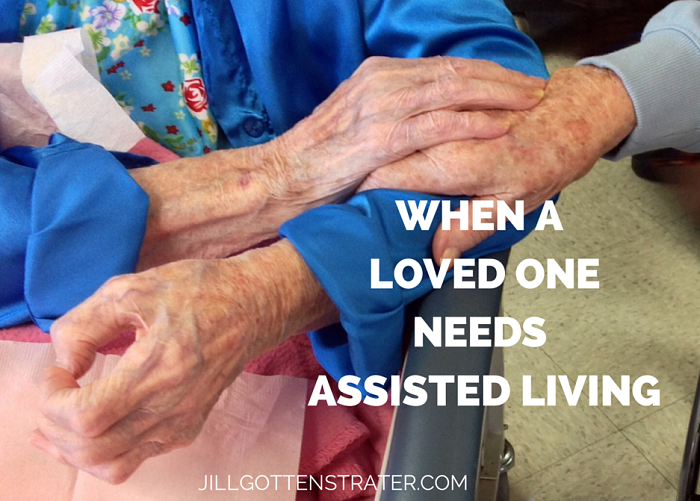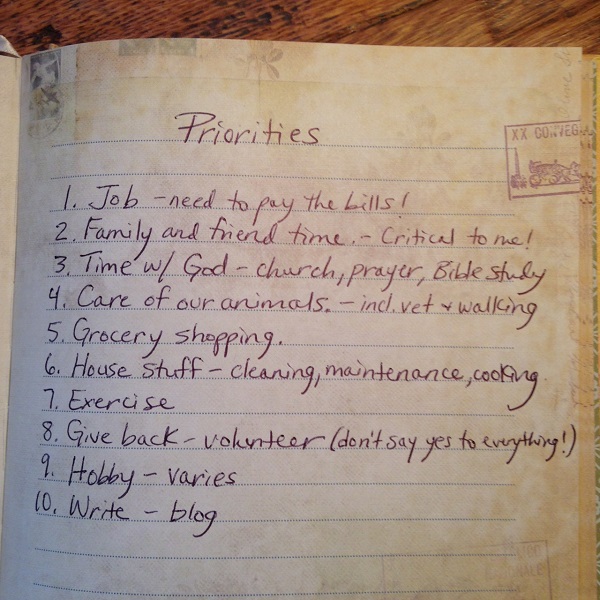When a Loved One Needs Assisted Living
On the heels of my empty nester post last week, I come to you today with another life scenario that many of us will experience in our lifetimes. A question many families find themselves asking is, “Does my aging loved one need to go to an assisted living facility or nursing home?”
Whether it be a parent, an in-law, a sibling, or maybe even a spouse, there comes a time when one loses their ability to live the independent lifestyle that they are accustomed to. This leaves the family faced with hard conversations and decisions to make.
It wasn’t on my radar to write about this topic, but I received a note from a reader who asked if I might consider writing a post to share some insight on this unfamiliar and difficult road. I have several friends who are in the process of weeding through such a decision, as well as some trusted friends in the health care field, so I figured I better get to work and do some research!
While talking to friends going through this process, the common theme which emerged was that the process of compiling a care plan for their loved one became overwhelming, confusing, and frustrating.
These situations are not easy for anyone involved and every situation has its own unique variables. There are no cookie cutter answers and the resources available will vary by city and state. The key is to form a plan that honors your loved one and considers their values, financial situation and wishes.
After extensive research online and interviewing several people, I hope you find the information provided here helpful and informative.
Before we get rolling, I’ve realized how much easier things can be if one puts some thought into advanced planning.
Not only will this provide you and your family with peace of mind for the future, but it will take the burden off your loved ones, should the need for assisted or skilled care come about in the future.
Here are two tips to consider:
- Purchase a long term health care plan. Plans will vary, so make sure you read the fine print and consult with an organization or person you trust. An attorney or care manager may also be utilized to clarify the policy. The costs associated with eldercare can be great, so it’s a good idea to get the best insurance plan you can afford.
- Create a clear “getting old” plan and communicate your wishes with loved ones. Most of us will want to stay at home as long as possible, but in the event the need arises for in-home assistance, moving in with relatives, or relocating to an assisted or skilled nursing facility, be open to the various alternatives. Prepare for the worst and plan for the best! Most of us have prepared a legal will, right? You’re dead when that’s executed, don’t you think a care plan that will serve you well while you’re living is just as, or more important, too?
OK, the reality is, some of us are not planners and we might not feel comfortable broaching this subject with our loved ones. We may also find ourselves dealing with these sorts of decisions earlier than we could have ever anticipated. So what do we do then?
Amy Fowler knows a thing or two about being thrown into a difficult situation earlier than she could have ever anticipated. Her father was diagnosed at age 59 with Mild Cognitive Impairment which led to Early Onset Alzheimer’s. Several years later, he is now in the end stages of Advanced Alzheimer’s. Do you think her family ever dreamed they would begin navigating his care at age 59?
In an attempt to make the most informed decisions for her dad’s care, Amy’s family employed a Geriatric Care Manager. A care manager works with families to help maintain the well-being, independence, and dignity of elders while balancing the specific needs of the families caring for them.
Amy’s family’s care manager not only provided options for resources, but the critical emotional support needed during the difficult process as well.
Through this difficult process, Amy came to realize that she wanted to help people like her family’s care manager had. With her passion for working with elders and a heart to honor her father at the same time, she started her own Geriatric Care Management business in Asheville, NC.
Amy and I sat down and discussed eldercare options. She began, “95% of the time, I will recommend someone utilize a care manager because often times you don’t need to place your loved one in an assisted living facility.” She explained that when people make the decision to move a loved one into an assisted living or nursing home, in many cases, that decision is made out of fear and from a lack of knowledge as to what the options and resources available are.
A care manager is able to assess the situation from an objective standpoint and provide valuable insight, direction, and support.
Whether or not you decide to utilize a care manager, Amy suggests considering the following alternatives to assisted living and/or nursing home facilities.
Cool Technology: Amy blew my mind with all the cool gadgets which are available to help a person maintain their independence at home with a little help. “A big reason people move into assisted living is because they need assistance with medications.” There are medication management systems that can be set up to send an alert via telephone to a neighbor or family member if the automatically dispensed dosage is not taken. How cool is that!? With those prone to wandering, there are door and bed sensors to alert others of movement. The list goes on and on, so make sure to look into the amazing technology available to help your loved one.
Adult Day Care: “Adult day care is one of the best kept secrets,” shared Amy. “This option saved my family. My dad would go to adult day care each day and thought he was going to work. He felt like he had a purpose,” Amy said. This is an excellent option to delay or prevent the need for assisted living, or in many cases, even the more skilled nursing care. It allows for socialization and exercise, and some facilities will even provide hygiene care. This is a much less expensive option than assisted living or Skilled Care. The national average cost/day for adult day care is $60. (Adult day health care programs are also available with nursing and CNA staff.)
Private Duty Agency Caregivers: These agencies can arrange for a caregiver to come into the home for a set amount of hours to help with certain tasks. The care can include observation, assistance, and/or skilled nursing care. This service can be used independently or paired with adult day care. Amy gives a scenario in which a person doesn’t need overnight care, but they might need help in the morning getting up, eating, and being transported to the adult day care. Most agencies have a 3-4 hour minimum, but Amy said it is reasonable to ask the private duty agency to do a split shift, where the caregiver comes in the morning for a couple hours, drops the person at Adult Day Care, picks them up later in the day, and helps them eat and get settled for the evening. You can expect to pay somewhere between $18 – $25/hour for this type of service. If this option is utilized 24/7, it can be very expensive. (This is not to be confused with a personal caregiver which may be $10/hour, but has not been vetted or represented by an agency.)
Note: Another term to be familiar with is Home Health Care. Home health is generally ordered at discharge from a hospital and is covered under Medicare for a certain period of time, whereas Private Duty care is not covered by Medicare.
Amy points out that after having considered these three options, you may come to the conclusion that an assisted living or skilled nursing facility is the best fit for your loved one. Here’s the kicker! “Assisted living facilities are not all created equal, Unlike skilled nursing facilities, which, because they offer rehab through Medicare, have stringent requirements and regulations that they have to adhere to, assisted living facilities can do as much or as little as they like to when it comes to care.”
This being said, just be careful to determine the care needs of your loved one and find a place that will serve them well. Where one person may need a facility with a full-time nurse or med tech on-site at all times, another may just need some oversight because they’re of advanced age.
Another thing to consider when researching assisted living facilities is finding out whether they charge a base rate each month, or a level-of-care fee. Amy points out that one is not better than the other, it’s just important to determine the level of care that is needed, pay for the things you need, and refrain from paying for items or services that you don’t need. For example, if you only need a little medication management and prompting to go to the dining room, that is considered lower level care, and the fees won’t be as high as those for someone who needs incontinent care. Because facilities provide various services, make sure to find out if some are automatically included, but charged for. For example, does the facility automatically utilize and charge for WanderGuard© (a bracelet that alerts facility staff if a resident is wandering)? If your loved one does not wander, there is no need to pay for that service. Amy stressed the importance to “be a savvy consumer and asking the right questions.”
I know I might sound like an ad for care managers, but in doing my research for this post, I see how complicated, delicate, and emotionally charged these decisions are. This may be one of the biggest decisions of your life, so bringing in an expert, like a Care Manager, to help guide you through the process seems like no-brainer to me.
To locate a Geriatric Care Manager in your state, visit CareManager.org. As with any professional you hire, check references.
If you are looking at care options in the Asheville, NC and surrounding areas, I highly recommend using the services of Amy Fowler. I have known her for nearly 10 years and I can tell you, she has a heart of gold and a super sharp mind. Click here to visit her website.
Care managers generally charge an hourly rate of $60 – $200/hour, depending on your city and state, and unfortunately most insurance plans will not cover this service. I asked if there was a ballpark number of hours a typical family would use, but as you can imagine, it varies from case to case. Amy shared that for some people it’s pretty quick – they meet for an initial assessment, she creates a ‘road map’ for the family, and they are good to go. Others prefer to have a more hands-on relationship.
Are you struggling with someone who needs help but DOES NOT WANT TO relocate?
Amy offers the following advice for you: “Be compassionate, and try to hear where they are coming from, because it is probably a place of fear. Engage a care manager, who is a 3rd party, who can help present the information in a non-confrontational way and engage the older person in the discussion so they feel empowered in helping to make that decision.”
Here’s the deal: Unless someone is declared incompetent, you cannot force them to do something they don’t want to. With any conflict, a mediator can often bring a peace and resolution to even the ugliest of situations.
So, let’s assume you have determined that a move to an assisted or skilled nursing facility is necessary.
If you are working with a care manager, utilize their expertise, knowledge, and relationships in selecting a facility.
If you are not using a care manager, make sure to do your homework.
When searching for an assisted or skilled nursing care facility, go ahead and do your work online, but always visit the facility in person to see how it looks, smells, and feels. Talk to the staff and the residents that are sitting in the halls. Sit in on an activity and lunch. Watch the interactions between the staff and residents.
To review skilled nursing care facilities, go to Medicare.gov and click on ‘Find nursing homes’.
Home, Sweet Home
Stay vigilant after your loved one has made the move. You want their new home to be a safe and comfortable place to live. Here are a few tips friends gave based on their experiences:
- Show up for visits often and at different times of the day. It is important that the workers of each shift know who you are and are aware that you are a consistent presence in your loved one’s life.
- Just because a person is not ambulatory doesn’t mean they shouldn’t be dressed each day. A friend told me that she hangs seven entire outfits (undergarments, shirt, pants, socks and shoes) in her mother’s closet at her nursing home. This helps to keep the staff accountable for dressing her each day and keeps her mama looking good. The cold, hard truth is that people treat you different if you are clean and presentable.
- Review the care plan from time to time and make sure if anything changes, everyone is aware and on the same page. For example, if a blood pressure medication is increased, make sure everyone is aware.
- If you see something that is being done wrong (not flagrantly), give criticism/direction kindly and make sure it is recorded with the supervisor so it remains on permanent record. For example, if you have told the staff not to give your father yogurt because it causes him to break out in a rash, but they continue to give him yogurt every morning anyway, try complimenting them on something they do well, followed by a reminder not to go against the care plan orders.
Well, I hope this will help someone. Now, I’ve got to run and call my dad and stepmom to see what their “long-term” plans are!
As always, I appreciate your feedback, comments, and questions. Please leave them in the comments section below. You never know when your comment might help someone else.
Jill xx
P.S. The picture above is my 100 year old Granny (in the blue coat) holding the hand of her dear 101 year old roommate at their skilled nursing home facility in Arkansas. They watch out for each other. Have you seen anything sweeter!?!







